| |
| |
But there are more than 50 Civil War sites, and I retain a keen interest in seeing many more, so we continue . . . |
 15-year-old Don looks at the forest at the Wilderness,
15-year-old Don looks at the forest at the Wilderness,
not long after the Civil War centennial (photo by B.B. Roberson; June 1967) |
 Somewhat later, an older Don sees his first re-enactment at the Mansfield sesquicentennial (photo by Rita Carratello, April 2014) |
|
| |
|
|
|
|
# |
Site |
Comments |
Photo |
Visits |
51 |
Carthage
Battle of Carthage State Historic Site & Museum
Missouri

|
The little battle of Carthage, in southwest Missouri, was the the "first serious conflict between U.S. troops and the rebels," preceding the First Battle of Manassas in Virginia by two weeks. Union troops under Col. Franz Sigel were outnumbered 6-to-1 by rebel militia and Missouri State Guard under pro-Southern Governor Claiborne Jackson. The running battle on 5 July 1861 spanned fields, streams, and the center of town, and included Sigel's use of European-style "infantry squares" as a tactic. At day's end, Sigel retreated to safety by marching to Sarcoxie.
Carthage has a Civil War driving route with a good brochure to sites of interest across the sprawling battlefield around the small town. There is an amazing little museum with a big 3D battlefield map with tiny soldiers, and on the museum walls hang striking art, including the painting of gray-clad Union soldiers retreating through Carthage [this was before "blue" and "gray" became standard colors of opposing forces]. It was a lot of fun to visit here. |
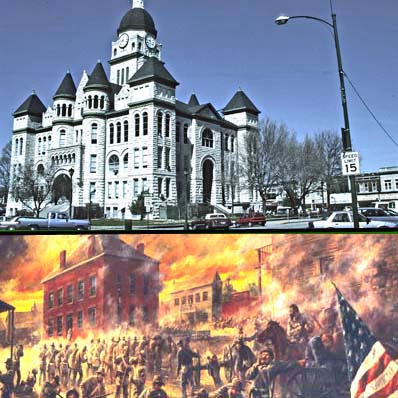 Carthage city hall today (top) and art showing gray-clad Union troops marching through burning Carthage in 1861 (bottom; Mar 1997)
Carthage city hall today (top) and art showing gray-clad Union troops marching through burning Carthage in 1861 (bottom; Mar 1997) |
Mar
1997 |
52 |
Five Forks
Five Forks Battlefield, Petersburg National Battlefield
Virginia

|
In 1865, Union Gen. "Little Phil" Sheridan returned from his Shenandoah Valley campaign to join Grant at the siege of Petersburg. Grant sent Sheridan with 13,000 cavalry to the west in a plan to force Lee out of his Petersburg trenches. R.E. Lee countered by dispatching Gen. George Pickett with 19000 men, including Fitzhugh Lee's cavalry, to hold the Southside railroad, Lee's only means of escape. Sheridan attacked on 1 April while Pickett & Fitzhugh Lee were at a shad bake at Hatchers Run. Pickett ran a gauntlet of enemy fire to reach his army at Five Forks. Union Gen. Warren's troops helped win victory, but Sheridan relieved Warren for "lack of aggressiveness" during the fight. [A Court of Inquiry exonerated Warren in 1881, 16 years later]. The battle cut the last rail line supporting Petersburg, causing Lee to abandon that city and the defense of Richmond. Final surrender was at Appomattox Courthouse two weeks later.
During our 1997 visit, the battlefield was not yet well-interpreted. There was one monument, a crumbling historic house, and a driving route. I am uncertain if more can be seen today. |
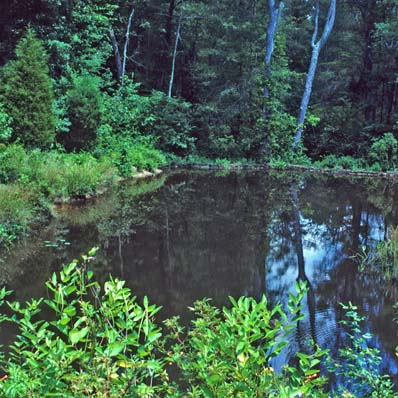
Hatchers Run on Five Forks battlefield,
site of Pickett's (in)famous "shad fry" (Aug 1997) |
Aug
1997 |
53 |
Battery Wagner Charleston
Fort Sumter
National Monument
South Carolina |
Battery Wagner was a sand fortification, supported by palmetto logs, on Morris Island that covered the southern approach to Charleston harbor. Its arsenal included 14 cannons, and its land face was protected by a moat, buried land mines, and sharpened stakes. Taking Charleston was a Union objective, so taking the Battery was considered necessary. Two beach assaults were made: 11 July 1863 and a more famous one 18 July, led by the 54th Massachusetts Volunteer Infantry, composed of black soldiers. Col. Robert Gould Shaw led the charge and was killed. The assaults failed but Battery Wagner was abandoned in Sep 1863, primarily from lack of water. Later, two drunk Union soldiers went exploring the bomb proofs and set off stored gunpowder, killing and injuring another 300 Union soldiers.
Battery Wagner was washed away by the Atlantic long ago, but Morris Island still exists and the approximate site can be viewed across a channel. The movie Glory tells the story most dramatically. |
 Contemporary painting of the Union attack on Battery Wagner (top); Contemporary painting of the Union attack on Battery Wagner (top);
looking across towards Morris Island today
(below; Aug 1997) |
Aug
1997 |
54 |
Baxter Springs
Baxter Springs Civil War tour route
Kansas

|
It was near the outskirts of the little prairie town of Baxter Springs, Kansas, on 4 Oct 1863, that up to 500 Missouri guerillas, led by bushwhacker William Quantrill who had burned Lawrence, Kansas back in August, surprised and overwhelmed a party of ~100 Union troops under Gen. James Blunt. About half were massacred, many while attempting to surrender. Quantrill's official report stated that he "took no prisoners." Women, children, and members of the regimental band were among those killed. Gen. Blunt barely escaped after a wild ride on his horse.
This is about the only site where one can see a locale specific to the vicious guerilla warfare that engulfed Missouri and Kansas during the War. An auto tour with printed pamphlet takes one to various sites, including the massacre field, and the local cemetery with its huge monument to Union dead.
|
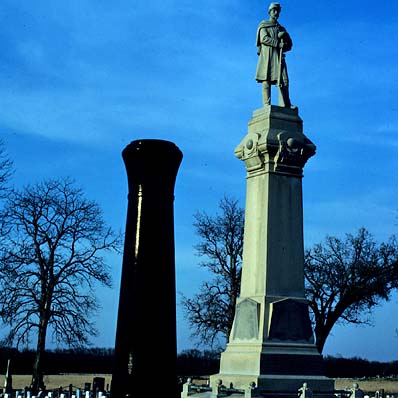 Cemetery & Soldier Monument at Baxter Springs KS (Mar 1997)
Cemetery & Soldier Monument at Baxter Springs KS (Mar 1997) |
Mar
1997 |
55 |
Brices Cross Roads
Brices Cross Roads National Battlefield Site
Mississippi
|
On 10 June 1864, 7800 Union infantry and cavalry under Gen. Samuel Sturgis, sent from Memphis to destroy CSA forces under Nathan Bedford Forrest, were ambushed and routed by Forrest's cavalry at Brices Cross Roads. Not only did Forrest defeat the Union force with less than half as many men, but he captured 16 cannon and all Sturgis's 250 baggage wagons with ammunition and supplies. It was one of the worst Union disasters of the War.
During my 1997 visit, the entire Site was one acre with a sign, a flagpole, a monument, and a couple of cannon. A real estate office glowered over the field, traffic sped by, and power lines ruined every view. From the perspective of the interested visitor, it was pathetic. However, I've read that local citizens formed a commission to preserve battlefield land, and with assistance from the Civil War Trust have purchased over 800 acres. Plus, I'm told, a Brice's Crossroads Museum is in Baldwyn, just over a mile from the site. So I look forward to a much enhanced visit some day.
|

A couple of cannons and a flagpole were about the entire
extent of the one-acre site in 1997 (Mar 1997) |
|
56 |
Kellys Ford
Kellys Ford Battlefield
Virginia

|
This battle between Union cavalry (under William Averell) and CSA horsemen (under Fitzhugh Lee) took place on March 17, 1863, after newly appointed Union commander Joe Hooker had reorganized Union cavalry. Averell forced a crossing of the Rappahannock at Kelly's Ford and repulsed several counterattacks, forcing the rebel cavalry back several miles. Confederate artillerist John Pelham, more of an observer here without his artillery, was killed aided a southern counterattack. With potential victory at hand, Averell withdrew to Union territory that evening, leaving his major aim -- to crush Lee's cavalry -- unfulfilled.
This site has not been interpreted until very recently. The Civil War Trust recently acquired nearly 1200 acres. During my visit in May 2013, only limited signage was up and much of the newly-acquired land was not yet open. I was able to visit the the memorial to “the Gallant Pelham,” named for his courage at Fredericksburg the preceding winter, along the Rappahannock River Trail on adjacent C.F. Phelps WMA. At the time of this writing, I am not sure what the Trust will do to open and/or interpret this mostly wooded site. It is a nice area for wildlife. |
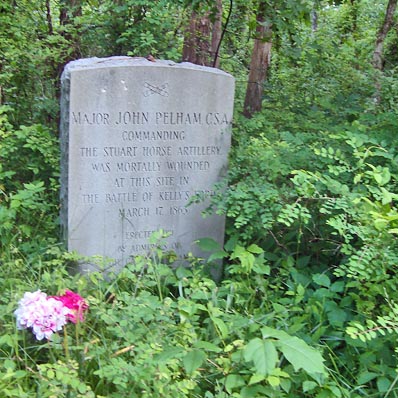 Memorial at site of the death of "the Gallant Pelham," near Kelly's Ford
(May 2013) Memorial at site of the death of "the Gallant Pelham," near Kelly's Ford
(May 2013) |
May
2013 |
57 |
Drewrys Bluff
Richmond National Battlefield
Virginia
|
As part of U.S. Grant's overall plan for victory in Virginia in 1864, the Army of the James was created to threaten Richmond from the south. Gen. Benjamin Butler, an important politician, was placed in charge. In a confused series of fights 4-16 May 1864, hampered by fog and rain, his Army was "bottled up" by Confederate forces at Bermuda Hundred, a bend in the James River, and were basically out of the war thereafter. Rebel guns at Drewrys Bluff were important, as they stopped Union gunboats attempting to assist Butler.
The battlefields in this 'side' part of the 1864 campaign were not preserved, excepting Drewrys Bluff itself, where one can view Confederate fortifications and have a fine view over the James River.
|
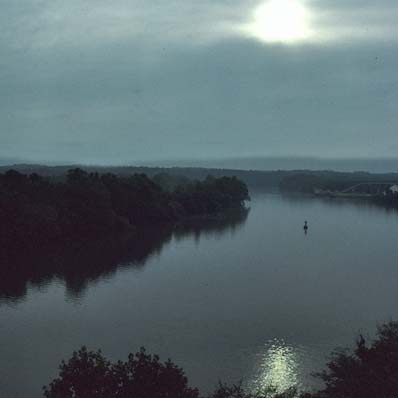 View over the James River from Drewrys Bluff
View over the James River from Drewrys Bluff
with storm clouds approaching
(Aug 1997) |
Aug
1997 |
58 |
Yorktown
Colonial National Historic Park -- Yorktown Battlefield
Virginia

|
The Yorktown Battlefield is where the British army surrendered to the Americans to end the Revolutionary War in Oct 1781. It is primarily preserved and interpreted for its major importance in the 18th Century (and is excellent from that perspective). During the Civil War, Confederate troops were besieged here by Gen. George McClellan during his Peninsular Campaign in Apr 1862. Yorktown was abandoned by the rebels on May 3, 1862. The National Park Service provides signs about its part during the Civil War (below).
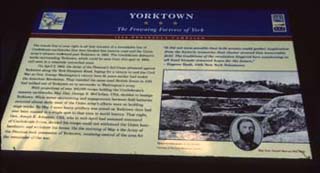
|
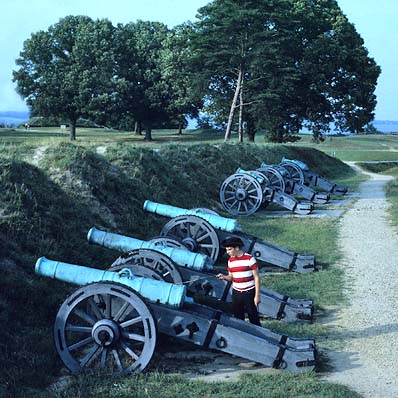
Revolutionary War siege line; that's me at age 15
(June 1967; photo by B.B. Roberson) |
June
1967,
Aug
1997
|
|
RECOMMENDED BOOKS & MEDIA :
51. Battle of Carthage
- Books: The standard work is David C. Hinze & Karen Farnham's (1997) The Battle of Carthage: Border War in Southwest Missouri. It is an hour-by-hour account of the sprawling little battle, enlivened by excellent maps and photos of the locales as they look today. In addition, Phillip Steele & Steve Cottrell's (1993) Civil War in the Ozarks, a slim paperback, is a lively retelling of the War in southwestern Missouri, and covers the highlights of the Battle of Carthage reasonably well in a few short pages. It also has lots of period photographs.
52. Battle of Five Forks
- Books: I have three books in my library that cover this battle, and to tell the truth, I have not actually read any of them entirely. Ed Bearss & Chris Calkins' (1985) Battle of Five Forks, 2d. ed., is a well-researched but dry formal battle history; Chris Calkins' (1997) The Appomattox Campaign: March 29-April 9, 1865 is a more colorful account with sidebars and vignettes (and will be the one I read first); Richard Wheeler's (1989) Witness of Appomattox is a popularized account without footnotes (and presumably without any original research).
53. Battles at Battery Wagner
- Media: The outstanding 1989 movie Glory, directed by Edward Zwick and starring Matthew Broderick (as Col. Robert Gould Shaw), Denzel Washington, Cary Elwes and Morgan Freeman (as soldiers), tells the story of the 54th Massachusetts Volunteer Infantry, one of the first formal units of the U.S. Army to be made up entirely of African American men, from their recruitment to the attack on Battery Wagner. It won three Academy Awards, including Denzel Washington as best supporting actor. While the lives and characters of individual soldiers are fiction, the details regarding Col. Shaw, the unit's recruitment, training, pay, and experiences, and the attack on Battery Wagner, were historically accurate. A few details were time-compressed or compilations of several units, but this is a great historical movie, not just a great cinematic movie.
- Books: Stephen R. Wise's (1994) Gate of Hell: Campaign for Charleston Harbor, 1863, is the standard here, with good maps and photos.
54. Battle of Brices Crossroads
- Books: Edwin C. Bearss's (1979) Forrest at Brice's Cross Roads must be the standard history. It has good maps and period photos. Yet, Bearss's writing style is nothing like his narrative style for tours (or for the Ken Burns' Civil War series). I found myself bogged down early on in the minutiae of movements of specific units, and quickly lose track of the 'big picture.' The book is heavy to pick up and is written in 'old style' battle histories. It would have been so much better to have the great Ed Bearss recite the highlights on a book-on-tape! I found that Stewart L. Bennett's (2012) paperback book, The Battle of Brice's Crossroads, in the Civil War Sesquicentennial Series, easily to read and understand, with period photos, current battlefield photos, and maps more to my taste.
55. Baxter Springs massacre
- Movie: The 1999 movie Ride with the Devil, with Tobey Maguire and directed by Ang Lee, portrays a group of Missouri bushwhackers, including their participation in the burning of Lawrence, Kansas, in Aug 1863. Some of the movie portrays actual historic events, and I felt it handled those events with reasonable accuracy. The movie follows a Confederate, played by Maguire, but is even-handed in its approach to right-or-wrong in the circumstances. I recommend it.
- Books: Edward Leslie's (1996) The Devil Knows How to Ride: the True Story of William Clarke Quantrill and His Confederate Raiders is a fine history of this sad piece of American history, and includes lengthy accounts of both the Sack of Lawrence and the Baxter Springs Massacre.
56. Battle of Kelly's Ford
- Books: I haven't read a book on this battle.
57. Battle of Drewrys Bluff
- Books: The battles of the Army of the James are very much a side-show to mainstream Civil War history, but William G. Robertson's (1987) Back Door to Richmond: the Bermuda Hundred Campaign, April-June 1864 is excellent, with plenty of maps and photos, and is highly reviewed by many readers. In addition, Edward G. Longacre's (1997) Army of Amateurs: General Benjamin F. Butler and the Army of the James, 1863-1865 covers their campaigns, including a half-dozen pages devoted to Drewrys Bluff.
58. Battle of Yorktown
- Books: The Civil War siege of Yorktown is covered in Stephen W. Sears' (1992) To the Gates of Richard: the Peninsula Campaign.
Other sites visited
- Picacho Peak, Arizona
- Corinth, Mississippi [prior to American Battlefield Trust acquistions]
- Tupelo, Mississippi
- Nashville, Tennessee [prior to American Battlefield Trust acquistions]
- Spring Hill, Tennessee [prior to American Battlefield Trust acquistions]
Civil War sites not yet visited include the following
- Westport, Missouri
- Arkansas Post, Arkansas
- Cane River Crossing, Louisiana
- Mansura, Louisiana
- Monet's Ferry, Louisiana
- Fort Jackson & Ft. St. Philip, Louisiana
- Jackson, Mississippi
- Raymond, Mississippi
- Champion's Hill, Mississippi
- Fort Pillow, Tennessee
- Richmond, Kentucky
- Fort Pulaski, Georgia
- Kennesaw Mt., Georgia
- Yellow Tavern, Virginia
- Port Republic, Virginia
- Cross Keys, Virginia
- Monocracy, Maryland
For most of these listed, I believe that there is at least something to see -- at least a roadside historic marker, if nothing else -- and others have developed battlefields to visit. We shall aim at seeing some of these in coming trips "back East." |
or the choices via links at right:
|
|
|
|
|


 Somewhat later, an older Don sees his first re-enactment at the Mansfield sesquicentennial (photo by Rita Carratello, April 2014)
Somewhat later, an older Don sees his first re-enactment at the Mansfield sesquicentennial (photo by Rita Carratello, April 2014) 



 Contemporary painting of the Union attack on Battery Wagner (top);
Contemporary painting of the Union attack on Battery Wagner (top); 


 Memorial at site of the death of "the Gallant Pelham," near Kelly's Ford
(May 2013)
Memorial at site of the death of "the Gallant Pelham," near Kelly's Ford
(May 2013)


